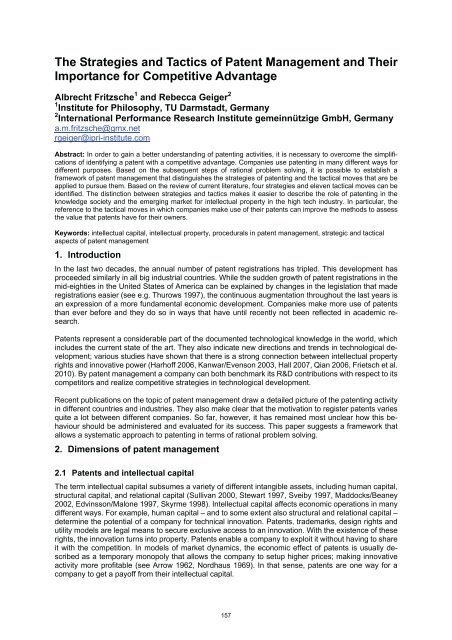Proceedings of the 3rd European Conference on Intellectual Capital
Proceedings of the 3rd European Conference on Intellectual Capital
Proceedings of the 3rd European Conference on Intellectual Capital
You also want an ePaper? Increase the reach of your titles
YUMPU automatically turns print PDFs into web optimized ePapers that Google loves.
The Strategies and Tactics <str<strong>on</strong>g>of</str<strong>on</strong>g> Patent Management and Their<br />
Importance for Competitive Advantage<br />
Albrecht Fritzsche 1 and Rebecca Geiger 2<br />
1<br />
Institute for Philosophy, TU Darmstadt, Germany<br />
2<br />
Internati<strong>on</strong>al Performance Research Institute gemeinnützige GmbH, Germany<br />
a.m.fritzsche@gmx.net<br />
rgeiger@ipri-institute.com<br />
Abstract: In order to gain a better understanding <str<strong>on</strong>g>of</str<strong>on</strong>g> patenting activities, it is necessary to overcome <str<strong>on</strong>g>the</str<strong>on</strong>g> simplificati<strong>on</strong>s<br />
<str<strong>on</strong>g>of</str<strong>on</strong>g> identifying a patent with a competitive advantage. Companies use patenting in many different ways for<br />
different purposes. Based <strong>on</strong> <str<strong>on</strong>g>the</str<strong>on</strong>g> subsequent steps <str<strong>on</strong>g>of</str<strong>on</strong>g> rati<strong>on</strong>al problem solving, it is possible to establish a<br />
framework <str<strong>on</strong>g>of</str<strong>on</strong>g> patent management that distinguishes <str<strong>on</strong>g>the</str<strong>on</strong>g> strategies <str<strong>on</strong>g>of</str<strong>on</strong>g> patenting and <str<strong>on</strong>g>the</str<strong>on</strong>g> tactical moves that are be<br />
applied to pursue <str<strong>on</strong>g>the</str<strong>on</strong>g>m. Based <strong>on</strong> <str<strong>on</strong>g>the</str<strong>on</strong>g> review <str<strong>on</strong>g>of</str<strong>on</strong>g> current literature, four strategies and eleven tactical moves can be<br />
identified. The distincti<strong>on</strong> between strategies and tactics makes it easier to describe <str<strong>on</strong>g>the</str<strong>on</strong>g> role <str<strong>on</strong>g>of</str<strong>on</strong>g> patenting in <str<strong>on</strong>g>the</str<strong>on</strong>g><br />
knowledge society and <str<strong>on</strong>g>the</str<strong>on</strong>g> emerging market for intellectual property in <str<strong>on</strong>g>the</str<strong>on</strong>g> high tech industry. In particular, <str<strong>on</strong>g>the</str<strong>on</strong>g><br />
reference to <str<strong>on</strong>g>the</str<strong>on</strong>g> tactical moves in which companies make use <str<strong>on</strong>g>of</str<strong>on</strong>g> <str<strong>on</strong>g>the</str<strong>on</strong>g>ir patents can improve <str<strong>on</strong>g>the</str<strong>on</strong>g> methods to assess<br />
<str<strong>on</strong>g>the</str<strong>on</strong>g> value that patents have for <str<strong>on</strong>g>the</str<strong>on</strong>g>ir owners.<br />
Keywords: intellectual capital, intellectual property, procedurals in patent management, strategic and tactical<br />
aspects <str<strong>on</strong>g>of</str<strong>on</strong>g> patent management<br />
1. Introducti<strong>on</strong><br />
In <str<strong>on</strong>g>the</str<strong>on</strong>g> last two decades, <str<strong>on</strong>g>the</str<strong>on</strong>g> annual number <str<strong>on</strong>g>of</str<strong>on</strong>g> patent registrati<strong>on</strong>s has tripled. This development has<br />
proceeded similarly in all big industrial countries. While <str<strong>on</strong>g>the</str<strong>on</strong>g> sudden growth <str<strong>on</strong>g>of</str<strong>on</strong>g> patent registrati<strong>on</strong>s in <str<strong>on</strong>g>the</str<strong>on</strong>g><br />
mid-eighties in <str<strong>on</strong>g>the</str<strong>on</strong>g> United States <str<strong>on</strong>g>of</str<strong>on</strong>g> America can be explained by changes in <str<strong>on</strong>g>the</str<strong>on</strong>g> legislati<strong>on</strong> that made<br />
registrati<strong>on</strong>s easier (see e.g. Thurows 1997), <str<strong>on</strong>g>the</str<strong>on</strong>g> c<strong>on</strong>tinuous augmentati<strong>on</strong> throughout <str<strong>on</strong>g>the</str<strong>on</strong>g> last years is<br />
an expressi<strong>on</strong> <str<strong>on</strong>g>of</str<strong>on</strong>g> a more fundamental ec<strong>on</strong>omic development. Companies make more use <str<strong>on</strong>g>of</str<strong>on</strong>g> patents<br />
than ever before and <str<strong>on</strong>g>the</str<strong>on</strong>g>y do so in ways that have until recently not been reflected in academic research.<br />
Patents represent a c<strong>on</strong>siderable part <str<strong>on</strong>g>of</str<strong>on</strong>g> <str<strong>on</strong>g>the</str<strong>on</strong>g> documented technological knowledge in <str<strong>on</strong>g>the</str<strong>on</strong>g> world, which<br />
includes <str<strong>on</strong>g>the</str<strong>on</strong>g> current state <str<strong>on</strong>g>of</str<strong>on</strong>g> <str<strong>on</strong>g>the</str<strong>on</strong>g> art. They also indicate new directi<strong>on</strong>s and trends in technological development;<br />
various studies have shown that <str<strong>on</strong>g>the</str<strong>on</strong>g>re is a str<strong>on</strong>g c<strong>on</strong>necti<strong>on</strong> between intellectual property<br />
rights and innovative power (Harh<str<strong>on</strong>g>of</str<strong>on</strong>g>f 2006, Kanwar/Evens<strong>on</strong> 2003, Hall 2007, Qian 2006, Frietsch et al.<br />
2010). By patent management a company can both benchmark its R&D c<strong>on</strong>tributi<strong>on</strong>s with respect to its<br />
competitors and realize competitive strategies in technological development.<br />
Recent publicati<strong>on</strong>s <strong>on</strong> <str<strong>on</strong>g>the</str<strong>on</strong>g> topic <str<strong>on</strong>g>of</str<strong>on</strong>g> patent management draw a detailed picture <str<strong>on</strong>g>of</str<strong>on</strong>g> <str<strong>on</strong>g>the</str<strong>on</strong>g> patenting activity<br />
in different countries and industries. They also make clear that <str<strong>on</strong>g>the</str<strong>on</strong>g> motivati<strong>on</strong> to register patents varies<br />
quite a lot between different companies. So far, however, it has remained most unclear how this behaviour<br />
should be administered and evaluated for its success. This paper suggests a framework that<br />
allows a systematic approach to patenting in terms <str<strong>on</strong>g>of</str<strong>on</strong>g> rati<strong>on</strong>al problem solving.<br />
2. Dimensi<strong>on</strong>s <str<strong>on</strong>g>of</str<strong>on</strong>g> patent management<br />
2.1 Patents and intellectual capital<br />
The term intellectual capital subsumes a variety <str<strong>on</strong>g>of</str<strong>on</strong>g> different intangible assets, including human capital,<br />
structural capital, and relati<strong>on</strong>al capital (Sullivan 2000, Stewart 1997, Sveiby 1997, Maddocks/Beaney<br />
2002, Edvinss<strong>on</strong>/Mal<strong>on</strong>e 1997, Skyrme 1998). <strong>Intellectual</strong> capital affects ec<strong>on</strong>omic operati<strong>on</strong>s in many<br />
different ways. For example, human capital – and to some extent also structural and relati<strong>on</strong>al capital –<br />
determine <str<strong>on</strong>g>the</str<strong>on</strong>g> potential <str<strong>on</strong>g>of</str<strong>on</strong>g> a company for technical innovati<strong>on</strong>. Patents, trademarks, design rights and<br />
utility models are legal means to secure exclusive access to an innovati<strong>on</strong>. With <str<strong>on</strong>g>the</str<strong>on</strong>g> existence <str<strong>on</strong>g>of</str<strong>on</strong>g> <str<strong>on</strong>g>the</str<strong>on</strong>g>se<br />
rights, <str<strong>on</strong>g>the</str<strong>on</strong>g> innovati<strong>on</strong> turns into property. Patents enable a company to exploit it without having to share<br />
it with <str<strong>on</strong>g>the</str<strong>on</strong>g> competiti<strong>on</strong>. In models <str<strong>on</strong>g>of</str<strong>on</strong>g> market dynamics, <str<strong>on</strong>g>the</str<strong>on</strong>g> ec<strong>on</strong>omic effect <str<strong>on</strong>g>of</str<strong>on</strong>g> patents is usually described<br />
as a temporary m<strong>on</strong>opoly that allows <str<strong>on</strong>g>the</str<strong>on</strong>g> company to setup higher prices; making innovative<br />
activity more pr<str<strong>on</strong>g>of</str<strong>on</strong>g>itable (see Arrow 1962, Nordhaus 1969). In that sense, patents are <strong>on</strong>e way for a<br />
company to get a pay<str<strong>on</strong>g>of</str<strong>on</strong>g>f from <str<strong>on</strong>g>the</str<strong>on</strong>g>ir intellectual capital.<br />
157
















